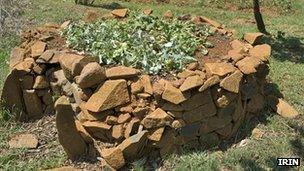Africa: Feeding the rising urban population
- Published
xx.jpg)
Any available vacant plot of land is being converted into vegetable gardens
More than half the world's population already lives in cities and the urban population of sub-Saharan Africa is projected to double by 2030.
According to a report by the UN Food and Agricultural Organization (FAO), external, 600 million people in Africa will be living in 24 of the 30 fastest-growing cities by that time.
More than half of all residents in African cities currently live in overcrowded slums - many of whom survive on less than $2 a day.
The situation presents an enormous challenge to governments across the continent.
"African policymakers need to steer urbanisation from its current non-sustainable path towards healthier cities that ensure food and nutrition security, decent work and income, and a clean environment for all their citizens," says the FAO's Modibo Traore.
He says the production and supply of food is rarely considered when designing and managing cities.
"The perception has been that because food is available and can easily be bought in supermarkets or along the streets, that food will always be there," says Alexander Muller, of the Food for the Cities initiative, external.
"But when prices peaked in 2007-2008, and more than 20 countries faced food price-related riots, this perception began to change," he adds.
Furthermore, it is acknowledged that the consumption of processed foods, combined with sedentary lifestyles, increases the risk of heart diseases, diabetes and certain forms of cancer.
Forward Planning
Cities need to plan clean, decentralised markets, which will save poor households time and money and offer an alternative to unhealthy street food.
This is particularly important as an increasing number of young people leave their rural roots and, in some areas, farmers are producing less food.
"Developing sustainable market gardens to serve African cities requires policy makers to recognise the sector's current contribution to the urban food supply and to urban livelihoods," says Mr Traore.
"They will need to protect land and water for market gardens and encourage growers to adopt eco-friendly farming practices that produce more, while reducing food contamination risks and protecting the environment," he says.
Urban horticulture across the African continent provides livelihoods for thousands of urban dwellers and food for millions more.
But market gardening has grown with little official recognition, regulation or support.
In some cities, market gardeners are maximising returns by using ever larger quantities of pesticide and polluted water.
Uncertainty prevails
The FAO report suggests that 40% of urban residents in sub-Saharan cities grow food.
Research has identified two basic types of urban crop production - home gardening, mainly for household consumption, and production in open spaces, mainly for market sale.
zz.jpg)
Even a handful of excess food can be sold to supplement a family's income
In the Senegalese capital, Dakar, 7,500 households grow their own vegetables in micro-gardens while in Malawi, 700,000 urban residents practise home gardening to meet their food needs and earn extra income.
However, most gardeners have no title to their land and could lose it overnight as land suitable for horticulture is taken for housing, industry and infrastructure.
That is the biggest fear of Liswani Wina in Zambia, who moved his family from the small town of Kabwe two years ago to find work in the capital.
"Things are just as bad in Lusaka," he says, "I can only find casual work two or three days a week."
To supplement his income, he grows vegetables on a plot of land the size of a basketball pitch adjacent to his dwelling.
It took Mr Wina almost a month to clear rubbish off the land and with a small loan from a microcredit agency, he bought seeds and pesticides.
"We are able to feed ourselves and we also have a bit left over to sell to neighbours," he says.
He puts aside the $20 a month he earns from his enterprise to pay for the education of his six children, but he worries about their future.
"A local official came along one day and said the land doesn't belong to me, but that I can continue growing my vegetables if I give him a percentage of the money we earn," he says.
"One day he will be greedy and take the land for himself," he laments, "And we will be back where we started."
Collaboration needed
Mr Wina's predicament highlights the need for national and local governments to support market gardening.
Market gardens create green belts that protect fragile areas, contain urban sprawl and build resilience to climate change.
The FAO says large areas of land could be set aside for horticulture and cites Kigali in Rwanda, where 15,000 hectares of land has been reserved for agriculture and wetlands, and Lagos in Nigeria where a similar approach has been taken with 4,400 hectares of land.

People have proven to be very enterprising when it comes to creating a vegetable garden
Treated waste water is safe and can supply most of the nutrients needed for horticulture, thereby decreasing the need to use drinking water.
Drip irrigation and rainwater harvesting also reduces demand on urban water supplies.
Horticulture provides livelihoods that are resilient to economic downturns and it can contribute to urban economic development.
According to the FAO, a good start is to encourage gardeners to form their own self-managed co-operatives, which can help them to diversify production, negotiate better prices, and improve post-harvest management.
"All stakeholders will need to co-operate in building an efficient urban fruit and vegetable supply system that provides fresh produce at a price all residents can afford," says Mr Traore.
"Growing greener cities in Africa will also help us to win the zero-hunger challenge," he concludes.
- Published2 December 2010
- Published24 November 2010
- Published30 August 2012